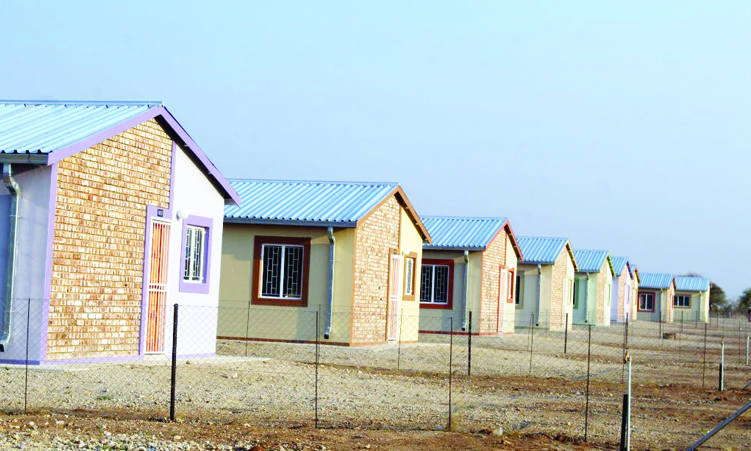In the face of Namibia’s 300 000-unit housing backlog, the Ministry of Urban and Rural Development has failed to meet a target to deliver 5 000 homes annually.
The government last year also set out to service 6 500 plots annually.
It said the country had an estimated housing backlog of around 300 000 units, with an estimated backlog of 84 000 units in Windhoek only.
According to the latest budget books, the ministry strived to construct 5 000 houses for the 2021/22 financial year, but managed to build only 1 479.
It serviced only 1 751 plots.
The government spent N$376,8 million on this under the ministry’s housing, habitat and technical services.
The year prior to this, the ministry only built 1 179 houses and serviced only 2 846.
Urban development ministry spokesperson Etuna Shikalepo on Tuesday said these targets were set as a result of the 20 000-house ambition detailed in the second Harambee Prosperity Plan (HPPII).
“It has to be pointed out that the targets set … are nationally, and are not only expected to be directly achieved by the lead ministry on housing matters or the government alone,” Shikalepo said.
She said the ministry has constructed 2 052 houses under various government supported initiatives between 1 March 2021 and 31 December 2022.
The HPPII promises to deliver 20 000 housing units countrywide by the end of the Harambee period, through public and private stakeholders.
The HPPII replaces the sixth National Development Plan after it lapsed last year.
The public and private sector stakeholders include the National Housing Enterprise (NHE), the Government Institutions Pension Fund (GIPF), the Shack Dwellers Federation of Namibia (SDFN), Ongos Valley, regional councils and local authorities, and other private sector developers.
The GIPF, in its latest annual report for the same period, indicated it has constructed 5 810 houses, while Ongos Valley says it has produced 480.
NHE
The NHE has built 1 065 houses from 2015 to May 2023, spokesperson Tuafi Shafombabi says.
This is despite the fact the company indicated in its 2015 to 2022 strategic plan that it intended to build 5 000 houses between 2017/18 and 2022/23.
Shafombabi says 105 453 people are on the NHE’s waiting list.
She says 122 houses were built at Rundu, 200 at Oshakati, 70 at Okahao, 100 at Omuthiya and 77 at Keetmanshoop.
During the same time, the NHE also built 72 houses at Karibib, four at Omaruru, and 10 at Ongwediva.
Outapi got 81 houses, while Okakarara and Otjiwarongo benefited from 40 houses each.
Windhoek (Goreangab) got 16 houses, while Tsandi got 30.
The NHE also built 70 houses for war veterans and 150 at informal settlements across the country, Shafombabi says.
The 1 065 houses together cost N$343 million, she says.
SHACK DWELLERS
The SDFN built 359 houses in the 2021/22 financial year.
Since the inception of this federation in 1987, it has built over 7 000 brick houses for its members countrywide.
The federation comprises 956 savings groups, with almost 30 000 members who have saved about N$39 million and built 7 224 houses to date.
In its most recent report, the federation said urban development in Namibia is currently driven by disciplinary divisions, outdated regulatory frameworks designed for low-density development, and limited public investment.
It said this is in the face of 40% of Namibians currently living in informal settlements or backyard shacks.
KEY PROBLEM
The ‘Africa Housing Finance Report for 2022’ states that the key challenge in the delivery of housing in Namibia is the lack of available serviced land.
Seven years ago, the Economic Association of Namibia also identified the root cause of the housing backlog as the inadequate provision of serviced land, particularly in and around Windhoek.
“This undersupply has driven the shortage of housing, which has in turn resulted in the major price increases we have witnessed over recent years,” it said in a report.
Popular Democratic Movement parliamentarian and shadow minister of urban and rural development Elma Dienda said the NHE is not executing its mandate of striving to promote home-ownership in Namibia.
“Their first mandate was to cater for low-income groups, but currently they are concentrating on people who earn more than N$8 000 per month.
“On top of that they fail even to get erven from municipalities. They must give back this responsibility to municipalities as it was before . . .
“Just another shameless parastatal who are giving fat salaries to their management without considering the plight of the poor and homeless,” Dienda said.
OTHER HPPII PROMISES
Moreover, the HPPII also mentions the establishment of an urban development fund to supplement funding for the delivery of serviced land and housing by 2022, as well as the promulgation of the rent control bill and a rent control board.
The Ministry of Urban and Rural Development says the figures in the government’s accountability report are achieved through direct funding by or from the government in the national budget, and excludes the plots and houses delivered by private financiers and developers.
The ministry considers houses built by the private sector as housing provided by itself.
Shikalepo says low economic growth and consequent reduced revenue to the state and budgetary allocations contribute to the housing crisis.
“Under-reporting and data challenges are other factors,” she says.
A private sector analysis by the International Finance Corporation and the World Bank states that approximately 15 000 new households require accommodation each year in urban areas, and if the backlog is to be eradicated within a decade, an additional 30 000 housing units would be required annually.
Stay informed with The Namibian – your source for credible journalism. Get in-depth reporting and opinions for
only N$85 a month. Invest in journalism, invest in democracy –
Subscribe Now!










